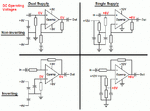adwnis123
Full Member level 4
I am trying to built an amplifier with a Gain = 3. After many simulations with LM386 that didn't work, I conclude in using LM741. But it works well with only +5,-5 Volt supply. So, my question is how I can get +5 Volt and -5 Volt simultaneously from a single 12 Volt power supply, in order to supply the LM741?
